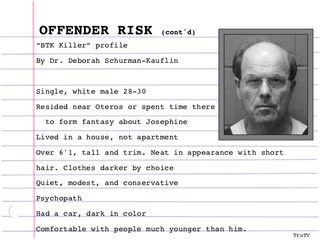Forensic Psychology
Criminal Profiling: The Original Mind Hunter
Profiling killers dates back to Jack the Ripper.
Posted December 4, 2017 Reviewed by Lybi Ma

The FBI formed its Behavioral Science Unit in 1974 to study serial predators. Since then, the art and craft of criminal profiling have become the subject of numerous books, TV shows and iconic films such as The Silence of the Lambs.
Continuing the trend, the Netflix series Mindhunter explores the early efforts of the FBI to understand and profile serial killers. Mindhunter is based in part on the writings of best-selling author Mark Olshaker and legendary FBI profiler John Douglas.
John Douglas is one of several pioneering FBI agents, along with the late Robert Ressler and Roy Hazelwood, who essentially invented computer-based, modern-day criminal profiling in the 1980s.
What exactly is criminal profiling or psychological profiling as it is sometimes called?
Profiling, or criminal investigative analysis, as it is called by the FBI, involves the investigation of a crime with the hope of identifying the responsible party, that is, an unknown perpetrator, based on crime scene analysis, forensic psychology, and behavioral science.
As explained by the APA in 2004, criminal profiling really is a combination of law enforcement and forensic psychology. Even today, it is a relatively new field with few set boundaries or definitions. Practitioners of criminal profiling do not always agree on methodology, procedures or even basic terminology. Despite their disagreements, however, practitioners of profiling all share a common goal of analyzing evidence gathered at a crime scene and statements provided by victims and witnesses to develop a description of an unknown offender (1).
Dr. Peter Vronsky noted that the offender description can include psychological factors such as antisocial personality traits, psychopathologies, behavioral patterns, as well as demographic variables including, age, race, and geographic location (2).
In practice, particularly as conducted by the FBI, criminal profiling is involved in the investigation, apprehension and prosecution phases of the criminal justice process.
In the investigation phase, profiling is used to determine whether or not crimes are linked and to predict the personality and lifestyle characteristics of an unknown perpetrator. In the investigation phase, profiling is used to develop strategies to apprehend the unknown criminal and to assess the likelihood of an escalation in the perpetrator’s crimes.
In the apprehension phase, profiling is used to predict where to look for an unknown serial criminal, to determine what information should be included in a search warrant, and how he/she may react upon apprehension. In the prosecution phase, criminal profilers act as experts in court to link crimes based on forensic evidence and to connect an alleged perpetrator to a series of crimes.
Profiling has a long and storied history. In what is frequently cited as the first application of criminal profiling techniques, London physicians George Phillips and Thomas Bond used autopsy results and crime scene evidence in the fall of 1888 to make rudimentary but informed predictions about legendary serial killer Jack the Ripper's personality, behavioral characteristics, and lifestyle (1).
In his written report after examining the available forensic evidence, including the bodies, Dr. Thomas Bond concluded that “all five murders no doubt were committed by the same hand… the women must have been lying down when murdered and in every case the throat was cut first.” Dr. Bond stated that Jack the Ripper had no medical training or knowledge of anatomy, despite the killer’s extensive cutting and mutilation of his victims.
This bold statement by Dr. Bond directly opposed what law enforcement authorities had previously concluded—that Jack the Ripper was either a physician or had medical training due to the fact that he had removed internal organs from some of his victims. Many law enforcement authorities at the time believed that the Ripper was, in fact, a surgeon.
Dr. Bond reached his conclusion that defied the consensus after noting that the gaping wounds inflicted by the Ripper were not consistent with the training of a medical expert or “even the technical knowledge of a butcher or horse slaughterer.” In his opinion, the murderer must have been “a man of solitary habits, subject to periodic attacks of homicidal and erotic mania, and the character of the mutilations possibly indicating satyriasis” or uncontrollable sexual desire. Of course, we will never know for sure if Dr. Bond was correct because the Jack the Ripper murders remain unsolved.
I will share more about modern-day criminal profiling, as developed and practiced by the FBI, in future articles here. I examine the fantasies and habits of notorious serial killers, including the “Son of Sam” and “Bind, Torture, Kill” based on my personal correspondence with both of them, in my book Why We Love Serial Killers: The Curious Appeal of the World’s Most Savage Murderers.
References
(1) Winerman, L. 2004. “Criminal profiling: The reality behind the myth.” Monitor on Psychology, 35 (7), pp. 66-69.
(2) Vronsky, P. 2004. Serial Killers: The Method and Madness of Monsters. New York: Berkley Books




